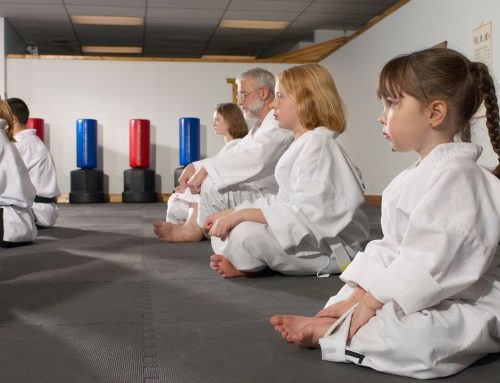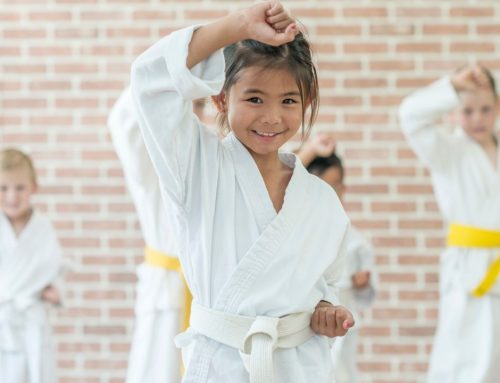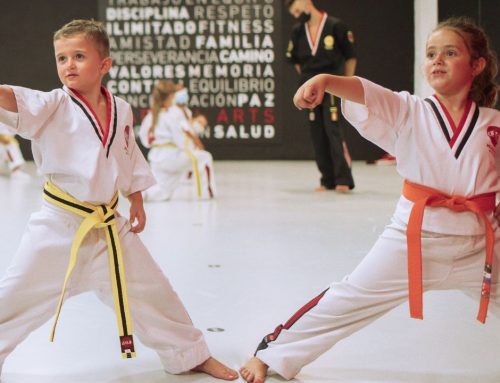
Empowering Young Warriors: Kick boxing for Kids
In the vibrant world of martial arts, where discipline meets dynamism, kick boxing for kids emerges as a powerful avenue for physical fitness, mental focus, and character development. Far beyond the realms of mere kicks and punches, kickboxing offers young enthusiasts a holistic approach to wellness, blending the excitement of a sport with valuable life skills. As parents seek activities that not only harness their children’s boundless energy but also nurture crucial attributes like discipline and confidence, kickboxing has emerged as a compelling choice.
In this exploration of kick boxing for kids, with Mugendo we delve into the multifaceted benefits that this dynamic sport brings to the younger generation. From fostering physical prowess to instilling discipline and self-confidence, kickboxing empowers young warriors to embark on a journey of personal growth and resilience. Join us as we unravel the exciting world of kickboxing tailored for kids, where each jab, cross, and kick becomes a stepping stone toward building strong bodies and even stronger characters. Welcome to a realm where little warriors don gloves, embrace discipline, and unleash their potential in the spirited arena of kickboxing.
What are kick boxing for kids classes like?
Kick boxing for kids can be a beneficial and enjoyable activity when approached in a safe and age-appropriate manner. Here are some key aspects to consider when it comes to kickboxing for kids. Also you can check our YouTube video below.
https://www.youtube.com/watch?v=eXnnO9Ewzrc
Supervised Environment:
It’s crucial to ensure that kickboxing classes for kids are conducted in a well-supervised environment. Qualified instructors who specialize in teaching children should oversee the training sessions.
Age-Appropriate Classes:
Classes should be designed specifically for different age groups, taking into account the physical and cognitive development of children. Younger kids may have different needs and abilities compared to older children.
Emphasis on Technique and Form:
The focus should be on teaching proper technique and form rather than intense sparring or competition. Children should learn the fundamental movements, strikes, and defensive techniques in a controlled manner.
Safety Gear:
Kids should always wear appropriate safety gear, including gloves, mouthguards, and shin guards, to minimize the risk of injury during training.
Physical Fitness and Conditioning:
Kickboxing can contribute to improving children’s physical fitness and overall conditioning. The training sessions may include warm-up exercises, stretching, and cardiovascular activities.
Discipline and Respect:
Kickboxing classes can instill discipline and teach children the importance of respect for themselves and others. Learning martial arts often involves following a code of conduct and showing respect to instructors and fellow participants.
Fun and Enjoyment:
It’s essential to keep the classes enjoyable and fun for kids. Incorporating games, challenges, and interactive activities can make the learning experience more engaging.
Building Confidence:
Kick boxing can help build children’s confidence as they learn new skills and see improvements in their abilities. Positive reinforcement and encouragement play a crucial role in fostering a sense of accomplishment.
Non-Contact Options:
Some kickboxing classes for kids may focus on non-contact or light-contact training to minimize the risk of injury. This allows children to enjoy the benefits of kickboxing without engaging in full-contact sparring.
Parental Involvement:
In some cases, parents may be encouraged to watch or even participate in classes with their kids. This not only allows parents to stay involved in their child’s activities but also provides a supportive and encouraging environment.
How much do kick boxing classes for children cost?
The cost of kickboxing classes for kids can vary widely depending on several factors, including the location, the reputation of the martial arts school, the expertise of the instructors, the facilities provided, and the duration and frequency of the classes. Additionally, whether the classes are part of a larger martial arts program or offered as standalone kickboxing sessions can also influence the cost.
On average, you can expect the cost for kickboxing classes for kids to range from $50 to $150 per month. Some schools may offer discounts for longer-term commitments, such as quarterly or yearly memberships. It’s important to inquire about any additional fees, such as registration fees or the cost of required uniforms and safety gear.
Here are a few things to consider regarding the cost of kickboxing classes for kids:
Trial Classes:
Many martial arts schools offer introductory or trial classes at a reduced cost or for free. This allows both the child and the parents to assess whether the classes are a good fit before committing to a long-term membership.
Membership Packages:
Some schools may offer different membership packages with varying levels of access to classes. For example, a basic package might include a certain number of classes per week, while a premium package may offer unlimited access.
Family Discounts:
If multiple children from the same family are enrolling, some schools provide family discounts to make the classes more affordable for parents.
Equipment Costs:
Factor in the cost of any required equipment, such as gloves, shin guards, and uniforms. Some schools may include these in the membership fee, while others may require a separate purchase.
Private Lessons:
If your child is interested in personalized attention, inquire about the availability and cost of private lessons. Private lessons are usually more expensive than group classes.
What age can you start kickboxing?
The age at which a child can start kickboxing can vary depending on the policies of individual martial arts schools and the child’s individual readiness. However, many martial arts schools offer classes specifically designed for children as young as 4 or 5 years old. It’s essential to find a program that emphasizes age-appropriate instruction and focuses on developing fundamental skills, discipline, and physical fitness in a fun and supportive environment.
Here are some general guidelines regarding the suitable age to start kickboxing:
Young Children (Ages 4-6):
Some martial arts schools offer introductory programs or “Little Dragons” classes tailored to the developmental needs of preschoolers and young children. These classes typically focus on basic motor skills, coordination, and fundamental movements, introducing martial arts concepts in an engaging and playful manner.
Children (Ages 7-12):
Many martial arts schools have specific children’s programs designed for kids aged 7 to 12. These classes gradually introduce more structured training, including basic techniques, forms (katas), and discipline. Instructors often incorporate age-appropriate games and activities to keep the classes enjoyable.
Teenagers and Adults:
Beyond the children’s programs, there are kickboxing classes for teenagers and adults. Teenagers, typically aged 13 and older, can join regular adult classes where they receive more advanced instruction and can participate in sparring and other aspects of kickboxing training.
What are the exercises for kick boxing for kids?
Kickboxing exercises for kids are designed to be fun, engaging, and beneficial for their physical development. These exercises typically focus on building strength, flexibility, coordination, and cardiovascular endurance. It’s essential to tailor the exercises to the age and skill level of the children and to ensure that safety measures are in place. Here are some kickboxing exercises suitable for kids:
Jumping Jacks:
An excellent warm-up exercise that gets the heart rate up and engages the entire body. Kids can perform jumping jacks in place or in a designated area.
High Knees:
Encourage kids to lift their knees as high as possible while marching or jogging in place. This exercise helps improve cardiovascular fitness and leg strength.
Front Kicks:
Teach kids how to execute front kicks using proper form. This exercise targets the legs and core muscles. They can practice kicking into the air or use soft pads for target practice.
Punching Drills:
Set up punching bags or pads for kids to practice basic punching techniques. Emphasize proper hand positioning and encourage controlled movements.
Shadow Boxing:
Guide kids through shadow boxing routines where they imitate the movements of a boxer without a physical target. This helps improve coordination and builds muscle memory.
Side Kicks:
Introduce side kicks to work on lateral movements and strengthen the muscles on the sides of the body. Ensure that kids maintain balance and control during the kicks.
Duck and Dodge:
Incorporate games or exercises that involve ducking and dodging imaginary punches. This improves agility and teaches kids how to move their bodies defensively.
Roundhouse Kicks:
Teach kids the basic mechanics of roundhouse kicks. Use target pads or soft pads for them to practice their kicks with proper form.
Agility Ladder Drills:
Set up an agility ladder and guide kids through various footwork drills. This enhances their foot speed, agility, and coordination.
Balancing Exercises:
Include exercises that focus on balance, such as standing on one leg or practicing kicks while maintaining stability. This helps improve proprioception.
Cool Down Stretches:
Finish the session with cool down stretches to improve flexibility and prevent muscle soreness. Include stretches for the legs, arms, and torso.
Is kickboxing a good sport for kids?
Kickboxing can be a good sport for kids, offering a range of physical, mental, and social benefits. However, whether kickboxing is suitable for a particular child depends on various factors, including the child’s age, temperament, and individual preferences. Here are some considerations to help determine if kickboxing is a good fit for a child:
Benefits of Kick boxing for Kids:
Physical Fitness:
Kickboxing provides a full-body workout, helping kids improve cardiovascular health, strength, flexibility, and coordination.
Discipline and Focus:
Martial arts, including kickboxing, often instill discipline and focus. Children learn to follow instructions, respect their instructors, and concentrate on their movements.
Confidence Building:
Achieving new skills and progressing in kickboxing can boost a child’s self-esteem and confidence. Setting and accomplishing goals contribute to a positive self-image.
Self-Defense Skills:
Kickboxing teaches basic self-defense techniques, promoting awareness and empowering children with skills to protect themselves.
Social Interaction:
Group kickboxing classes provide opportunities for social interaction and teamwork. Children can make friends, learn to work with others, and develop a sense of camaraderie.
Stress Relief:
Engaging in physical activity, such as kickboxing, can help children manage stress and release pent-up energy in a healthy way.
Coordination and Motor Skills:
Kickboxing involves a variety of movements that enhance coordination, balance, and overall motor skills.
Considerations:
Age Appropriateness:
While some martial arts schools offer classes for young children, it’s essential to ensure that the program is age-appropriate, emphasizing fun, basic movements, and safety.
Individual Readiness:
Children mature at different rates. Assess whether a child has the attention span, motor skills, and emotional readiness for kickboxing.
Instructor Qualifications:
Look for reputable martial arts schools with qualified instructors who have experience teaching children. Instructors should prioritize safety and create a positive learning environment.
Interest and Enthusiasm:
Consider the child’s interest and enthusiasm for kickboxing. Children are more likely to benefit if they genuinely enjoy the activity.
Balance with Other Activities:
Ensure that kickboxing fits well with the child’s schedule and doesn’t interfere with academic or other extracurricular commitments.
Parental Support:
Parents should be supportive and involved, attending classes if possible and encouraging a positive attitude toward learning and improvement.
DÉJA TU CALIFICACIÓN
¿Te ha sido útil el artículo? Si te ha gustado, te invitamos a que nos dejes una calificación positiva de 5 estrellas.









